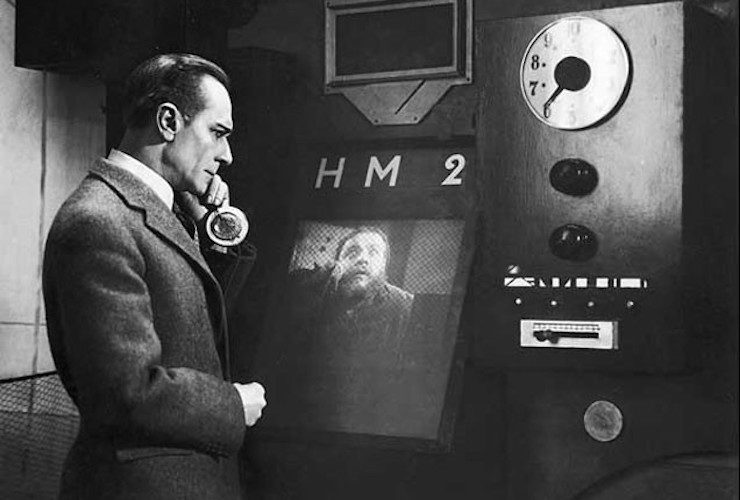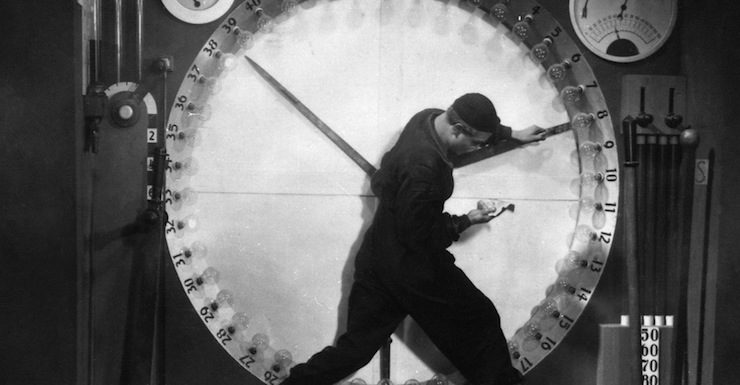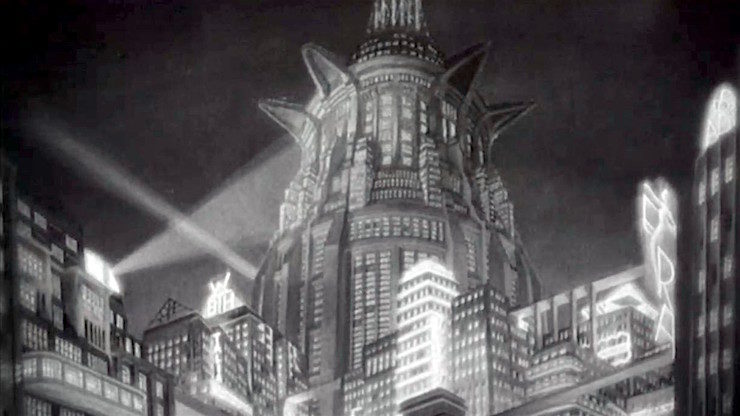H.G. Wells was of course very interested in the future. There is The Time Machine, which takes its inventor and operator much too far into the future, to find that the inequalities of the era in which the story was written have increased exponentially, with the degraded working classes having dysgenically morphed into apish and cannibalistic underworld-dwellers and the upper classes into small and feckless loafers, cared for by the others as farmers care for livestock, and for the same purposes. It was a powerful vision, no less powerful for being bizarrely unlikely (leaving aside the time-travel premise to begin with).
Oddly enough, in an era when projectors of utopias began to see the future as the right location for their new societies rather than hidden valleys or islands, Wells set his own (A Modern Utopia, 1905) on an alternative earth, set out in a striking metafictional form, with Wells as narrator describing to a London audience of his own time his admittedly imaginary adventures in a wonderful contra-earth. When Wells considered the near-term future, though, his vision was ambiguous at best, and dystopian at its core.
When the Sleeper Wakes is set only two hundred-plus years in the future (the dawn of the 22nd century); Graham, Wells’s Sleeper, is a near relation to the sleeper in Edward Bellamy’s futurist utopian romance Looking Backward, who falls asleep in 1887 and wakes in 2000. Bellamy’s sleeper finds himself in a wonderful and perfect (though pretty low-tech) America, while Wells’ Sleeper wakes to find that the wealth he accumulated in the 19th century has been earning interest and been invested in various enterprises while he slept. He’s the richest man in the world, and the council that controls his enterprises effectively rules the technological world. But what strikes a reader now in Wells’s future is how dominated it is by mass electronic video and audio communication.
It’s a common feature of futurist fiction that the least developed or most inchoate ideas put forth in it are the ones that readers seem to feel are predictive of present tech. In Wells’s conception the airplanes and immense tower cities and numberless cars are the usual melange of the unlikely and the dead-end that are pointed out as prophetic, but it’s his account of the social consequence of new media technology that has to strike our era as pretty amazing. The Sleeper gets his first glimpse of it: “On the flat surface was now a little picture, very vividly coloured, and in this picture were figures that moved. Not only did they move, but they were conversing in clear small voices. It was exactly like reality viewed through an inverted opera glass and heard through a long tube. His interest was seized at once by the situation which presented a man pacing up and down and vociferating angry things to a pretty but petulant woman. Both were in the picturesque costume which seemed so strange to Graham.” Soon “he heard himself named, heard ‘when the Sleeper wakes,’ used jestingly as a proverb for remote postponement, and passed himself by, a thing remote and incredible. But in a while he knew those two people like intimate friends… It was a strange world into which he had been permitted to look, unscrupulous, pleasure-seeking, energetic, subtle, a world too of dire economic struggle.”
What will take him a long time to grasp is that every person in the society with a penny to spend is able to see this scene at the same time. His own awakening was communicated to the world by “videophone.” This is the information/infotainment industry of the future, and even the desperate workers want to have it all the time. Books have ceased to interest either creators or the public; what’s wanted is the stuff created in “factories where feverishly competitive authors devised their phonograph discourses and advertisements and arranged the groupings and developments for their perpetually startling and novel kinematographic dramatic works.”

The Sleeper Awakes would have made a great film, though not one that could have been made in 1898, when the story first appeared, nor in 1910, when a revised version was published. It sort of was made into a film years later, though: Fritz Lang conceded, and Wells perceived, that Lang’s 1927 Metropolis contains many connections to Wells’s vision: the towering city, the enslaved proletariat, the manipulation of mass emotion. It was one of the most expensive films made up to that time.
Wells hated it.
He published a review in the New York Times that is one of the great takedowns of pretentious and ill-conceived futurism.
“I have recently seen the silliest film,” he begins. “I do not believe it would be possible to make one sillier.” And he admits: “Possibly I dislike this soupy whirlpool none the less because I find decaying fragments of my own juvenile work of thirty years ago, The Sleeper Awakes, floating about in it.”
Wells’s chief complaint is that the society pictured in Lang’s film can’t work in reality, for several reasons. There’s the vast crowd-packed city rising to towering heights, with the immense factory where the workers toil far down below: as Wells points out, this model — which was the model in The Sleeper Awakes — might have been workable “far away in the dear old 1897″ but even by 1927 factories were moving away from city centers, and so were populations. Far sillier are the conditions of labor and production that the film presents: the capitalist Joh Federsen has become fabulously wealthy on something the workers produce. We see a number of Model T-like cars come off a Ford-like assembly line, but, Wells wonders, who buys them? “There are a certain number of other people, and the ‘sons of the rich’ are seen disporting themselves, with underclad ladies in a sort of joy conservatory, rather like the ‘winter garden’ of an enterprising 1890 hotel during an orgy. The rest of the population is in a state of abject slavery, working in ‘shifts’ of ten hours in some mysteriously divided twenty-four hours, and with no money to spend or property or freedom.” Wells notes—it’s hard to miss and I thought it was the silliest thing in the movie when I first saw it—that the workers are slaves to machines, like the poor guy who actually has to manually control a clock that somehow controls the works. Did Lang not understand that the machines are designed to replace human drudgery, because machines are so much better at it? The social dislocations caused by that replacement are real, but no modern industrial society can be built on bare-faced slavery.

Wells is also unimpressed by the most magical and singular trick in the film: the imposition of the form of the saintly activist Maria on the Art Deco robot conceived by the scientist-wizard Rotwang. “Mary [her name in the English version] has to be trapped, put into a machine like a translucent cocktail shaker, and undergo all sorts of pyrotechnic treatment in order that her likeness may be transferred to the Robot. The possibility of Rotwang just simply making a Robot like her, evidently never entered the gifted producer’s head.”
Wells, committed wholly to the idea that his scientific romances could teach people to think more rationally about society, science, and themselves, couldn’t view Metropolis as a sort of transported Wagnerian saga unconnected to the actual world; he had to critique it for what it purported to be, which is a prediction of a future state of society. And on that basis none of his animadversions can be refuted. But it’s not all that can be said about the film, and especially the central mythography of the robot (a word and concept only just invented by Karel Capek in his play R.U.R.).
Some of our greatest film-makers are not particularly clear thinkers, nor free from a sort of instinctual sentimentality that extends to both good and evil. D.W. Griffith had it, and Steven Spielberg certainly has it. Lang had it too, and to it was added a mawkish religiosity that no viewer now (and I’d bet few then) could mistake as a genuine feeling for the spiritual. It’s story-telling from the gut or the heart, and tends to allow in unexamined inanities, even thrive on them; they can be the one thing an audience remembers. The operatic (if silent) hordes tending the great Moloch of capitalism are gripping even if what they’re doing is absurd under any figuration. The transformation, power, and final failure of the demonic Maria remains a central meme in the modern mythos of the robot; the conscious but conscienceless Ava in Ex Machina is her descendant. The fact that neither is actually possible as enacted doesn’t harm their fearful symmetry.
When the lights came up on Metropolis, Wells studied the house: “It was, I thought, an unresponsive audience, and I heard no comments. I could not tell from their bearing whether they believed that Metropolis was really a possible forecast or no. I do not know whether they thought that the film was hopelessly silly or the future of mankind hopelessly silly. But it must have been one thing or the other.”











 John Crowley was born in the appropriately liminal town of Presque Isle, Maine in 1942, his father then an officer in the US Army Air Corps. He grew up in Vermont, northeastern Kentucky and (for the longest stretch) Indiana, where he went to high school and college. He moved to New York City after college to make movie and found work in documentary films, an occupation he still pursues. He published his first novel The Deep in 1975, and his fifteenth volume of fiction, Four Freedoms, in 2009. His latest novel,
John Crowley was born in the appropriately liminal town of Presque Isle, Maine in 1942, his father then an officer in the US Army Air Corps. He grew up in Vermont, northeastern Kentucky and (for the longest stretch) Indiana, where he went to high school and college. He moved to New York City after college to make movie and found work in documentary films, an occupation he still pursues. He published his first novel The Deep in 1975, and his fifteenth volume of fiction, Four Freedoms, in 2009. His latest novel,